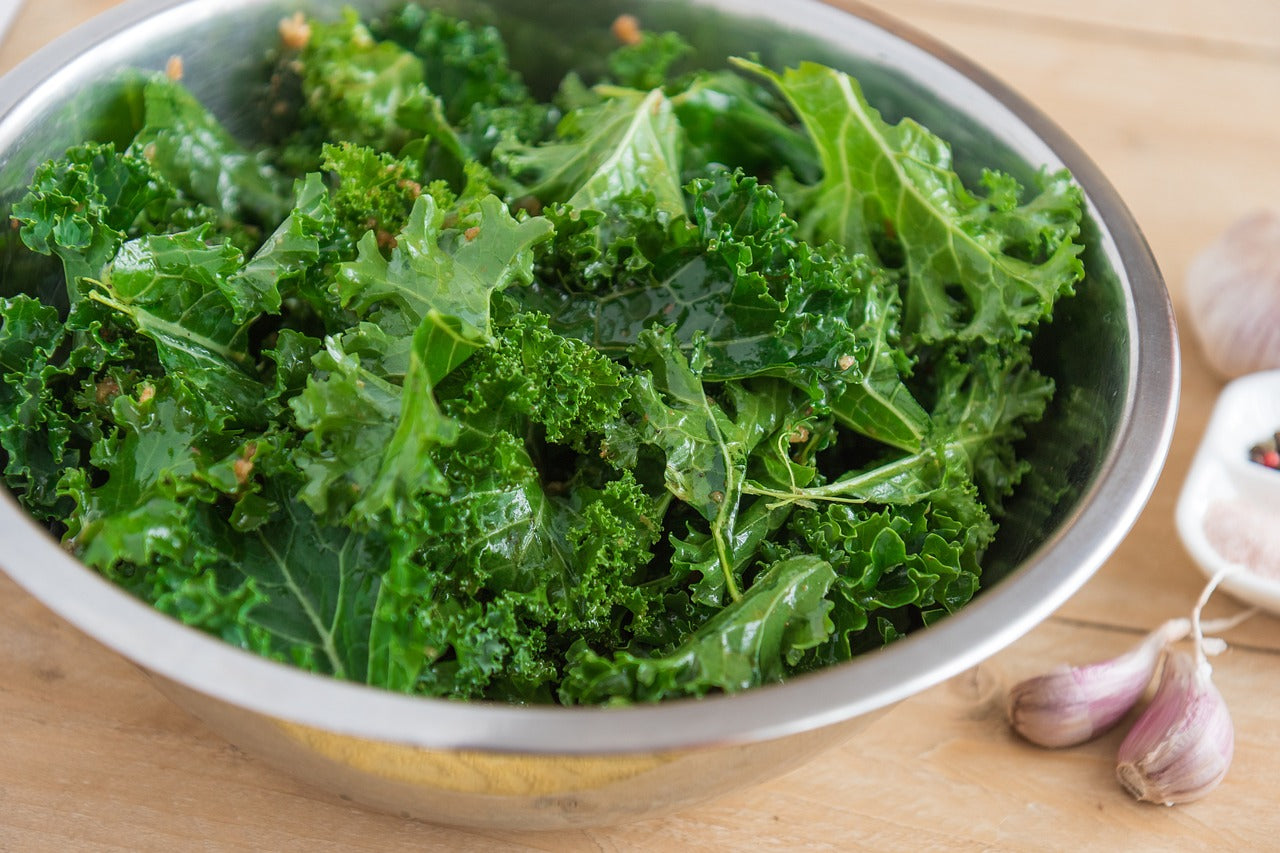
3 Good Reasons to Eat More Kale & 2 Reasons Not to
Kale was/is all the rage right now.
And I’m happy to endorse the fad. Because in truth, kale is an incredible addition to anyone’s diet.
This dark green, purplish-red leafy vegetable has some amazing health benefits… the likes of which you won’t find in many other food sources.
Kale might take a little bit of getting used to (as far as taste goes), but once you learn how to cook it you’ll find it quickly becomes one of your favorite go-to vegetables for helping you achieve “Health As It Ought To Be.”
7 Amazing Benefits of Kale
1. Contains more nutrients than almost any other plant in the world:
Of all the plants we’ve studied it looks like kale truly is “superfood” royalty.
Here’s how those stats break down:
A single cup of raw kale (about 67 grams or 2.4 ounces) contains:
- Vitamin A: 206% of the RDA (from beta-carotene).
- Vitamin K: 684% of the RDA.
- Vitamin C: 134% of the RDA.
- Vitamin B6: 9% of the RDA.
- Manganese: 26% of the RDA.
- Calcium: 9% of the RDA.
- Copper: 10% of the RDA.
- Potassium: 9% of the RDA.
- Magnesium: 6% of the RDA.
- Then it contains 3% or more of the RDA for Vitamin B1 (Thiamin), Vitamin B2 (Riboflavin), Vitamin B3 (Niacin), Iron and Phosphorus.
This is coming with a total of 33 calories, 6 grams of carbs (2 of which are fiber) and 3 grams of protein.
Pretty darn impressive huh?
2. It has powerful cancer fighting properties:
Cancer has been with humankind for as long as we’ve been around.
Caused by the uncontrolled growth of cells inside our body, cancer forms many times as the result of free-radical formation which affect cells’ internal replicating programming.
The reasons kale can help fight cancer is two fold.
First kale contains high amounts of some of the most powerful antioxidants in the world.
As you learned above, kale’s incredibly high in vitamins and minerals. Well it turns out some of those vitamins are actually powerful antioxidants. Vitamins A, C, and K are all shown to help improve the body’s immune function and help keep the body functioning as it was designed to.
Then there are powerful flavonoids and polyphenols inside of kale.
Polyphenols and flavonoids are chemicals made by fruits, vegetables and other edible plants which are known specifically for their health benefits.
Many of these these polyphenols have antioxidant/anti-inflammatory properties. This means they can help fight the free-radicals responsible for causing cancer.
Two of the most abundant of these powerful chemicals found in kale are flavonoids quercetin and kaempferol.
Numerous studies have shown them to be some of the more powerful chemicals in all of the world. They can work to:
- Protect the cardiovascular system
- Help fight viruses
- Lower blood pressure
- Boost mood
- And fight cancer
Not to mention kale also contains a few other powerful anti-cancer agents.
Authority Nutrition writes:
“Kale is actually loaded with compounds that are believed to have protective effects against cancer.
This includes sulforaphane, a substance that has been shown to help fight the formation of cancer at the molecular level.
It also contains a indole-3-carbinol, another substance that is believed to help prevent cancer.
Studies have shown that cruciferous vegetables (including kale) may significantly lower the risk of several cancers, although the evidence in humans is mixed.”
3. Kale might be able to help you lose weight:
One of the reasons is because of kale’s incredibly low energy density.
Since kale is primarily, water, nutrients, along with protein and fiber, whenever you eat it you’re not consuming a ton of calories. Calories as you know are the main culprit with weight gain.
The other fact is kale is quite filling. A cup of cooked kale is chock full of healthy fiber and protein which will provide you with a sense of fullness within mere minutes of consumption.
So that means two things are at work when you eat kale.
You’re consuming a low energy density food which has been shown to help with weight loss.
And, you’re eating a food which will fill you up and make it so you’re not ravenous enough to scour the cupboards for snacks guaranteed to pack on the pounds.
I do want to mention there aren’t any studies about kale and weight loss in particular, but knowing these two facts about kale allows me to conclude building a diet with kale as a centerpiece could eventually lead to some serious weight loss.
2 Reasons To Avoid Kale
Now I realize that kale seems like a “slam dunk” as one of the world’s healthiest foods.
But, there are a few important pieces of information I can’t leave out.
Kale does have a few properties which could make it problematic for certain portions of the population.
So before you decide you’re going to stock up on kale, go over these 2 checkpoints and make sure you’re OK to eat it.
1. Raw Kale can affect thyroid function:
Raw kale contains substances which have a goitrogenic effect. This means they affect the function of the thyroid in a negative way.
This is actually true of numerous cruciferous vegetables.
So if you’re suffering from a thyroid problem of any sort…it’s a good idea not to consume kale in its raw form.
Now with that being said, people with thyroid problems can still enjoy kale, it just means you’re going to want to do it once it’s cooked.
2. Kale’s contains a sugar called raffinose which can upset the digestive system:
Jacqui Gibbons writes:
“Raffinose belongs to a group of carbohydrates called oligosaccharides, meaning it is made up of several sugar molecules hooked together. It is found in cruciferous vegetables (the group that includes kale, cabbage and broccoli) as well as beans and legumes.
We lack the right enzymes to digest raffinose in our stomach or small intestine. So after passing through these organs it arrives in the large intestine still intact, and is then fermented by the bacteria there. Though it can ‘feed’ our good bacteria and encourage their growth, this fermentation also produces gases such as methane and carbon dioxide, which cause the well-known problems of bloating and flatulence that some people get after eating these foods.”
The gist here is if you want to avoid being bloated and gassy then test to see if kale makes you feel that way.
If it does it means your body has a hard time with this sugar and you should avoid it if at all possible.
Time To Enjoy Some Kale?
As I mentioned, kale is hard to get used to when it comes to taste.
Raw kale in particular.
My favorite way to enjoy kale is either in smoothies (raw) or cooked in kale chips.
Simply coat them in a health oil like olive oil or coconut oil and then bake until crispy and you’ve got a wonderful and healthy treat.
Try some kale on for size and tell me how you like it on Facebook.
Talk soon,
Dr. Wiggy
www.HealthAsItOughtToBe.com



